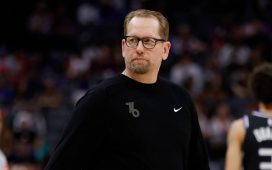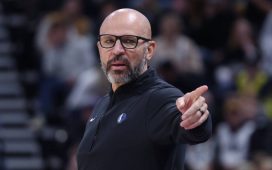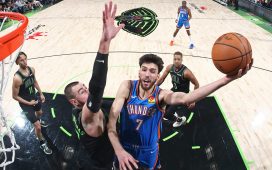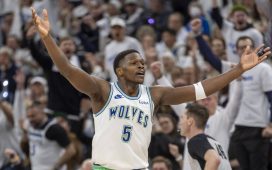Draft picks:
Departing players:
Other offseason news:
- Parted ways with head coach Larry Drew.
- Hired John Beilein as head coach.
- Hired J.B. Bickerstaff as associate head coach.
- Hired Lindsay Gottlieb as assistant coach.
- Team owner Dan Gilbert hospitalized with stroke symptoms.
Salary cap situation:
- Remained over the cap.
- Carrying approximately $129.77M in salary.
- Taxpayer mid-level exception ($5,718,000) still available.
- Note: The Cavaliers are below the tax apron ($138.93M) and could theoretically use the non-taxpayer mid-level exception and/or bi-annual exception, but wouldn’t be able to use those exceptions in full while staying below the apron.
Story of the summer:
LeBron James hasn’t suited up for the Cavaliers since June of 2018, but the franchise remains very much in transition mode following his departure. Most of the team’s expensive contracts for veteran players who were acquired to play alongside James won’t expire until after the 2019-20 season, meaning they were still clogging the cap this summer.
With all those contracts on the books, the Cavs had little flexibility to do anything in free agency. And since most of those vets on expiring deals don’t have positive trade value, the club also didn’t have much leverage to get anything done on the trade market.
As such, the Cavs had essentially completed their offseason work by the end of draft night. The team hired a new head coach in the spring, then added three first-round prospects at the draft. One of those three first-rounders – Kevin Porter Jr. – was acquired in Cleveland’s only trade in the offseason, and the cap-strapped club didn’t sign a single veteran free agent to a guaranteed contract.
While the Cavs may have liked to make a few more moves and accelerate their rebuild a little, their cap situation necessitated patience. The organization will be in a better position to be more active at this year’s trade deadline or in the 2020 offseason.
Key offseason losses:
None of the departing Cavaliers players were core pieces. Channing Frye and J.R. Smith were key contributors during the team’s NBA Finals years, but neither player saw much action last season, though Frye at least was still a positive presence in the locker room.
Marquese Chriss and Nik Stauskas, two former lottery picks, arrived in midseason trades and got a chance to make an impression in the Cavs’ rotation. Stauskas played well enough to earn a roster spot on a contender (Portland). However, Chriss struggled and has seemingly generated little interest on the free agent market this summer, just three years after he was drafted eighth overall. He remains unsigned.
David Nwaba is the other notable departure for the Cavs. The young swingman played some solid two-way ball in Cleveland last season, but he wasn’t in the team’s long-term plans. Despite the fact that he was eligible for restricted free agency, the Cavs did him a favor by declining to tender him a qualifying offer, allowing him to sign outright with the Nets.
Key offseason additions:
Having failed to secure a top-four pick in this year’s draft lottery, the Cavaliers missed out on the very best prospects in the 2019 rookie class, including Zion Williamson, Ja Morant, and RJ Barrett. With the No. 5 overall selection, Cleveland nabbed Darius Garland, the second point guard drafted in the top 10 by the team in the last two years.
If the Cavs viewed Garland as the best player available, he was the right pick in that spot, but it’s not an ideal outcome for the Cavs that their first two lottery picks in the post-LeBron era – Garland and Collin Sexton – essentially play the same position. While Sexton sounds bullish on the duo’s chances to emulate the success of Damian Lillard and CJ McCollum in Portland, that may be an unrealistic goal. It will be interesting to see how the two young guards complement one another.
Cleveland completed its draft by selecting Dylan Windler at No. 26 and Porter at No. 30. Windler, who made 3.0 three-pointers per game at a 42.9% rate in his final season at Belmont, will add some outside shooting to the roster, while Porter is the sort of low-risk, high-upside prospect the Cavs can afford to gamble on at this point in their rebuild — especially since the former USC Trojan became the first player in years to accept a salary lower than 120% of his rookie scale amount.





